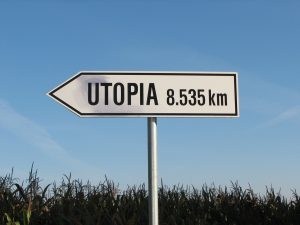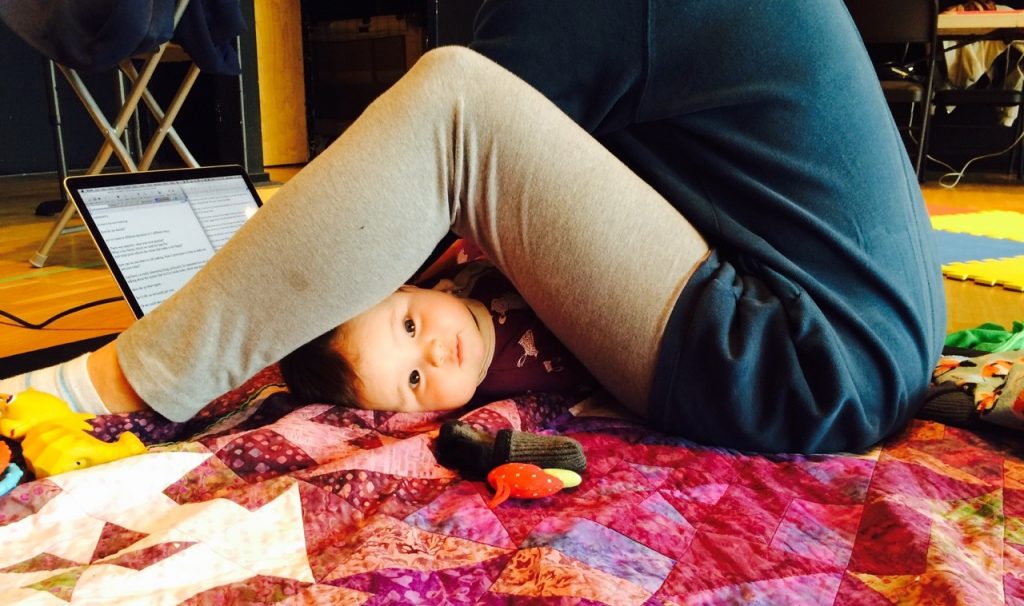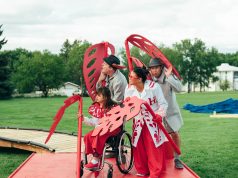Artist Jan Derbyshire introduced me to the concept of inclusive design. Jan and I have been working together for almost four years, and have applied many of these principles to our own creative processes, developing a cultural practice between us that has proven to be productive, flexible and adaptive to our changing needs over the years.
Inclusive Design isn’t just about accommodating artists and audiences with disabilities. Rather, it is a design principle that places the human who will be using the object, space, process or practice that is being designed at the centre of the drive to innovate and create. At its heart, inclusive design is a profoundly human and humane philosophical approach and recognizes the uniqueness of the individual – some of whom are unique in similar ways, and others who are not.
Diversity conversations in theatre tend to cluster around addressing groups defined by identifiable traits like gender or gender preference; racial or cultural background; and indigeneity. Recently, the conversations have expanded to address engagement with artists and audiences with disabilities. Inclusive design widens the frame even more and, by doing so, levels the playing field. Each artist’s needs are considered with equal weight. You need a ramp to get your wheelchair into the room? Cool. I need to be done by 3:30pm so I can pick up my kid from daycare. These become the conditions of the work, and not only guide the design of the creative process but broaden our definition of ‘diversity’.
Who wouldn’t want to work within a process that is responsive to and supportive of the very human needs we all have outside the rehearsal room? But there are economic forces at work that support the status quo and compel theatre producers to centralize time and effort, and apply what is, essentially, an industrial approach to the processes of art-making.
For example, Canadian Actors’ Equity agreements mandate rehearsal conditions and offer limited flexibility to pro-rate hours over multiple weeks (although new agreements are in the works to address this issue). Rehearsal venues are established in spaces converted from other uses because they are affordable, but these renovated environments don’t often have adequate physical accessibility (ramps, washrooms, etc). Managers of purpose-built spaces rarely consider accessibility beyond ramps, like tactile maps and special lighting. When was the last time you went to a theatre that had room for more than two wheelchairs at the same time?
As creators, innovators and makers within arts and culture, we are all designers. We plan the processes and develop the practices by which we train for, create, produce, administrate, and disseminate our work. Diversity and inclusion are consistent and thorny considerations within the workforce that supports, fuels, and populates our stages. Applying principles of inclusive design is one way to open up existing systems and spaces, and to devise new ones.
In Between the World And Me Ta-Nehisi Coates relates how in 1957 the white residents of Levittown, Pennsylvania argued against desegregating their community because they were “moral, religious, and law-abiding citizens.” These were people who saw themselves as ‘good’, and used the qualities that defined ‘goodness’ to rationalize a stance that we see now as reprehensible. Because “it’s 2016”, looking back to 1957 we can clearly see the racism masked behind their stated virtues of morality, religion and the law. Will our economic reasoning against addressing accessibility and inclusion when designing theatre spaces and practices seem like an equally quaint and flimsy argument to our future selves and successors?
When Jan tells me about the first principle of inclusive design, diverse participation and perspectives, she says, “if the system works for you, you’re the last person who’s going to question the system. So it’s looking at all the hierarchies that we have in theatre right now cause we are complicit in a lot of segregation.”

“The richness,” Jan says, “of going into what I like to call ‘eccentric communities’ has been that constant, really diverse way of looking at things and making things.”
I tell Jan that what excites me about the possibilities of widening the networks of creators is how the different ways of working lead to different kinds of work.
“That’s probably the most important part about all of this and why the focus isn’t just on disability. It’s asking ourselves how much of our practice, our process, our product is answering specific commercial needs.”
Inclusive design takes time, and attention – it is not the most efficient means of production.
“One size fits one,” says Jan, “It’s the idea that every time we meet we are actually two different people. Our experience changes in our lives, [and] that affects how we’re going to reach our goals and how we’re going to work.” She goes on to say, “it’s also the idea that if you design for the people the farthest out on the margins you actually develop systems that are of use for everybody.”
“What we’re working with in terms of cultural practice is really beginning to think differently about time, and how we can make that work inside the economic models that we have. Of course, it’s ‘easier for everyone’, that’s always the argument. But that thinking presupposes that you’re never going to have a change in your life, that you might not need some customization yourself, right?
“Another principle of inclusive design is the notion that disability is a mismatch. Disability is a trait, versus a condition. The medical model defines disability as something permanent and limiting. In contrast, inclusive design perceives disability as a mismatch between the needs of someone and the design features of a product, process or built environment. This is when we are absolutely complicit in this segregation.”
As practitioners, we are implicated in excluding artists with disabilities when we agree to locate our offices on the second floor of buildings that have no elevators; when our production timelines are condensed and inflexible; and when we continue to mistake busy-ness, long hours, and relentless multi-tasking as “working hard” rather than recognizing these as the unhealthy practices they are.
As we talk through the other five principles of inclusive design (see below for a summary of the all eight principles) I am, once-again, persuaded by Jan’s passion and thoughtfulness.
“I’ve met so many people that don’t get in and give up, and have voice and really interesting thoughts, but need development. But the training and the development is not happening. The highest value our schools have is endurance. If you can’t go to school for 16-hours a day and not work, you can’t do that.”
 Inclusive design is also about being a grown up: You must state, honestly and transparently, your needs and capacities. And theatre-making is uniquely suited to this process. Where else is such vulnerability prized? And where else is risk-taking equally valued? To design processes that elicit what Jan calls “the best of us”, we must make room for the physical, mental, and emotional needs. The vulnerability is met with generosity, the two hold each other accountable, and the work flies.
Inclusive design is also about being a grown up: You must state, honestly and transparently, your needs and capacities. And theatre-making is uniquely suited to this process. Where else is such vulnerability prized? And where else is risk-taking equally valued? To design processes that elicit what Jan calls “the best of us”, we must make room for the physical, mental, and emotional needs. The vulnerability is met with generosity, the two hold each other accountable, and the work flies.
“Inclusive design,” Jan says, “is open source, sharing, generosity. Because we can’t compete in the same way that a capitalist economy does. Yes, we have to live inside it, absolutely, and there’s very necessary realities around that, I understand that. But I think we can do better, and I think everybody knows that.
“And it’s not like we’re going to be able to meet the needs of every maker or every viewer all the time. But you should think about Utopia and shoot for it knowing you’ll never get there.”
Eight Principles of Inclusive Design
- Diverse Participation and Perspectives: inviting engagement from a broad range of people who have diverse needs, preferences, and interests.
- One Size Fits One: developing solutions and systems in response to the specific needs of the participants.
- Integrated Solutions: designing flexible processes that can incorporate and respond to changes along the way.
- Interconnectedness: keeping the conversations going so that they can become part of the mainstream.
- Disability is mismatch: disparity between the needs of the user or maker and the design features of the production, system or space.
- Virtuous Cycles: the opposite of a vicious cycle, by considering these principles when designing systems and spaces, the ideas gather momentum and can be considered more easily by the mainstream users and decision-makers.
- Autonomous Maker: educating and empowering Makers to design work conditions that address their needs.
- Maker Continued Designs: including Makers in the ongoing decision-making that comes out of the current conversations.










